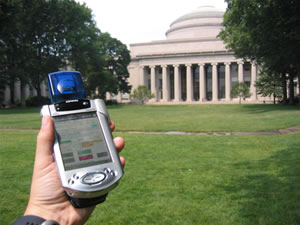Both video game and educational designers alike have long dreamed of the day when we will be able to use holographic imagery to create fully immersive virtual reality worlds for kids to explore. While researchers have made impressive attempts with systems such as the CAVE, at this point we are still nowhere near close to creating virtual worlds remotely as complete as the real world. What we can do, however, is to mod the real world.
In an experimental genre called Augmented Reality Gaming, game and/or curriculum designers use a variety of location aware technologies to intelligently layer game elements on top of the real physical world. In this way, designers are able to create games that, quite literally, have the most realistic graphics and lifelike sound capabilities theoretically possible.
 For educators, Augmented Reality Games open a number of possibilities for curricular design. By using the real world as the foundation of a game, the development of most game assets is already provided for free by our planet -- thereby lowering production costs. In particular, learning content that deals with invisible elements can be particularly well suited to this genre.
For educators, Augmented Reality Games open a number of possibilities for curricular design. By using the real world as the foundation of a game, the development of most game assets is already provided for free by our planet -- thereby lowering production costs. In particular, learning content that deals with invisible elements can be particularly well suited to this genre.
In one game, students use location-aware handheld computers to diagnose a simulated ecological contamination on MIT campus. Since the toxins involved are invisible, the handheld provides all the same information it would if it was doing a real soil analysis. In this way, the game perfectly re-creates the same experience as a real contamination, but carries numerous practical advantages over using real toxins.
![]() Overview of the Augmented Reality Game Environmental Detectives [external link]
Overview of the Augmented Reality Game Environmental Detectives [external link]
For language classes taught in the country of the target language, it becomes highly paradoxical that students would ever sit together in a classroom when the target culture lies just outside their walls. Often teachers take field trips and explore the city together, but in other activities it is simply necessary to use a classroom to maintain better control of the class and faciltate instruction. Clearly, however, the more tools we give teachers to organize instruction outside the classroom the better.
 Using tools such as the TEP AR editor, curricular designers can rapidly develop mobile games with learning content. After loading in geographic data for a given region, designers then set latitude and longitude coordinates where different game events are to occur. When players travel to those locations, the programmed events run, instructing them what to do at that location and/or requesting a decision to further the game.
Using tools such as the TEP AR editor, curricular designers can rapidly develop mobile games with learning content. After loading in geographic data for a given region, designers then set latitude and longitude coordinates where different game events are to occur. When players travel to those locations, the programmed events run, instructing them what to do at that location and/or requesting a decision to further the game.
![]() Reliving the Revolution: Example of a Completed Educational Augmented Reality Game Created by a Graduate Student with No Development Budget [External Link]
Reliving the Revolution: Example of a Completed Educational Augmented Reality Game Created by a Graduate Student with No Development Budget [External Link]
Note: currently the use of these games requires the purchase of a GPS enabled handheld device for each group of students working at a given time, making it most appropriate for larger institutions where multiple classes could all share the same equipment. However, much of the requisite technology is rapidly being included in devices such as cell phones and will likely be more widely available in the coming years. In particular, Japanese classes will likely find much of the requisite technology already common among youth.